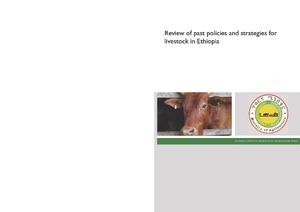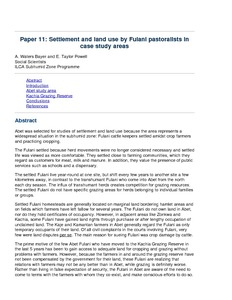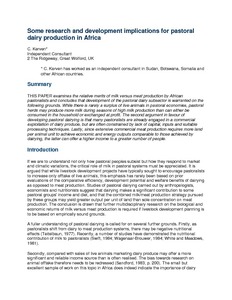Review of dairy marketing and processing in a semi-arid pastoral system in Ethiopia
Studies were conducted among pastoralists on the Borana Plateau in 1986-89. Household surveys described seasonal milk production and allocation, marketed supply of dairy products, incidence of calf morbidity and mortality and human consumption of dairy products and grain. The efficiency of butter-making was measured. Dairying among the Borana is controlled by the women. Overall, 69 percent of milk produced was used as fresh milk and the remainder was soured for direct consumption or butter processing.
Review of past policies and strategies for livestock in Ethiopia
Rift Valley fever in Kenyan pastoral livestock: Simulation with an individual-based demographic model
Rift Valley Fever (RVF) is a viral zoonosis and a mosquito-borne disease caused by a phlebovirus in the family Bunyaviridae. It affects livestock, humans and wildlife. Epidemic outbreaks of RVF in East Africa, which occur after heavy rainfalls in cycles of 5-15 years, have caused next to human morbidity and mortality considerable economic losses throughout the livestock production and market chain. Establishment of a pastoral livestock demographic model simulating alternating normal and drought periods (appropriate for the Sahel) and RVF epidemics.
Risk factors for sero-prevalence of tick-borne diseases of calves in Maasai pastoral herds in Kajiado District, Kenya
Scope for improvement of small ruminant production in the Sahel
This chapter investigates the options for improving the performance of small ruminants interms of their contribution to household incomes. The characteristics of the existing production system are first sketched in order to identify the resource requirements and constraints of the system. Based on this imformation, a steady-state flock model is then developed and used to assess the impact of variation in growth, reproduction and mortality rates production.
Settlement and land use by Fulani pastoralists in case study areas
Presents results of studies of settlement, land use & relations w. settled farmers of Fulani agropastoralists in Abet & Kachia Grazing Reserve in Subhumid Nigeria. Discusses reasons of choice of site, pattern & right of grazing and access to land.
Small ruminant research and development in Africa: proceedings of the Third Biennial Conference of the African Small Ruminant Research Network : UICC, Kampala, Uganda, 5-9 December 1994
This volume contains papers and abstracts of the Third Biennial Conference of the African Small Ruminant Research Network. In addition to the keynote address, there are nine papers on Genetic Resources Enhancement and Utilisation, seven papers on Production Systems, Policy and Economics, six papers on Management and Health, 12 papers and Feeding Systems and 10 papers on Performance and Reproduction. Six poster abstracts covering the above topics add to the volume.
Some aspects and implications of the development of grazing blocks in northern province, Kenya
Organizational and management problems associated w. development of grazing blocks in north eastern kenya w. spec. ref. to the Somali pastoralists and their socioeconomic organization.
Some research and development implications for pastoral dairy production in Africa
Examines the relative merits of milk versus meat production by African pastoralists. Discusses the implications for livestock development policy.
Spatial correlates of land-use changes in the Maasai-Steppe of Tanzania: Implications for conservation and environmental planning
Spatially explicit models are becoming increasingly important tools for simulating land-use change. In this study, we formulated and tested models that incorporated spatial correlates of agricultural expansion and used them to predict local- and landscape-scale patterns of agricultural land-use change and its implications in the Maasai-Steppe of Northern Tanzania. We evaluated the relationship between agricultural land-use and its spatial correlates using Multiple Logistic Regression on data derived from satellite imageries for the year 2000.







